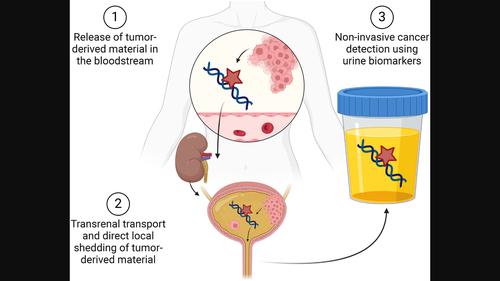当前位置:
X-MOL 学术
›
Mol. Oncol.
›
论文详情
Our official English website, www.x-mol.net, welcomes your feedback! (Note: you will need to create a separate account there.)
Unlocking the potential of tumor‐derived DNA in urine for cancer detection: methodological challenges and opportunities
Molecular Oncology ( IF 6.6 ) Pub Date : 2024-03-11 , DOI: 10.1002/1878-0261.13628 Birgit M. M. Wever 1, 2 , Renske D. M. Steenbergen 1, 2
Molecular Oncology ( IF 6.6 ) Pub Date : 2024-03-11 , DOI: 10.1002/1878-0261.13628 Birgit M. M. Wever 1, 2 , Renske D. M. Steenbergen 1, 2
Affiliation

|
High cancer mortality rates and the rising cancer burden worldwide drive the development of innovative methods in order to advance cancer diagnostics. Urine contains a viable source of tumor material and allows for self‐collection from home. Biomarker testing in this liquid biopsy represents a novel approach that is convenient for patients and can be effective in detecting cancer at a curable stage. Here, we set out to provide a detailed overview of the rationale behind urine‐based cancer detection, with a focus on non‐urological cancers, and its potential for cancer diagnostics. Moreover, evolving methodological challenges and untapped opportunities for urine biomarker testing are discussed, particularly emphasizing DNA methylation of tumor‐derived cell‐free DNA. We also provide future recommendations for technical advancements in urine‐based cancer detection and elaborate on potential mechanisms involved in the transrenal transport of cell‐free DNA.
中文翻译:

释放尿液中肿瘤来源 DNA 用于癌症检测的潜力:方法学挑战和机遇
全球范围内的高癌症死亡率和不断上升的癌症负担推动了创新方法的发展,以推进癌症诊断。尿液中含有肿瘤物质的可行来源,可以在家中自行收集。这种液体活检中的生物标志物测试代表了一种方便患者的新方法,并且可以有效地检测可治愈阶段的癌症。在这里,我们详细概述了基于尿液的癌症检测背后的基本原理,重点是非泌尿系统癌症及其在癌症诊断方面的潜力。此外,还讨论了尿液生物标志物检测中不断变化的方法学挑战和尚未开发的机遇,特别强调了肿瘤来源的无细胞 DNA 的 DNA 甲基化。我们还为基于尿液的癌症检测的技术进步提供未来建议,并详细阐述无细胞 DNA 经肾转运的潜在机制。
更新日期:2024-03-11
中文翻译:

释放尿液中肿瘤来源 DNA 用于癌症检测的潜力:方法学挑战和机遇
全球范围内的高癌症死亡率和不断上升的癌症负担推动了创新方法的发展,以推进癌症诊断。尿液中含有肿瘤物质的可行来源,可以在家中自行收集。这种液体活检中的生物标志物测试代表了一种方便患者的新方法,并且可以有效地检测可治愈阶段的癌症。在这里,我们详细概述了基于尿液的癌症检测背后的基本原理,重点是非泌尿系统癌症及其在癌症诊断方面的潜力。此外,还讨论了尿液生物标志物检测中不断变化的方法学挑战和尚未开发的机遇,特别强调了肿瘤来源的无细胞 DNA 的 DNA 甲基化。我们还为基于尿液的癌症检测的技术进步提供未来建议,并详细阐述无细胞 DNA 经肾转运的潜在机制。



























 京公网安备 11010802027423号
京公网安备 11010802027423号